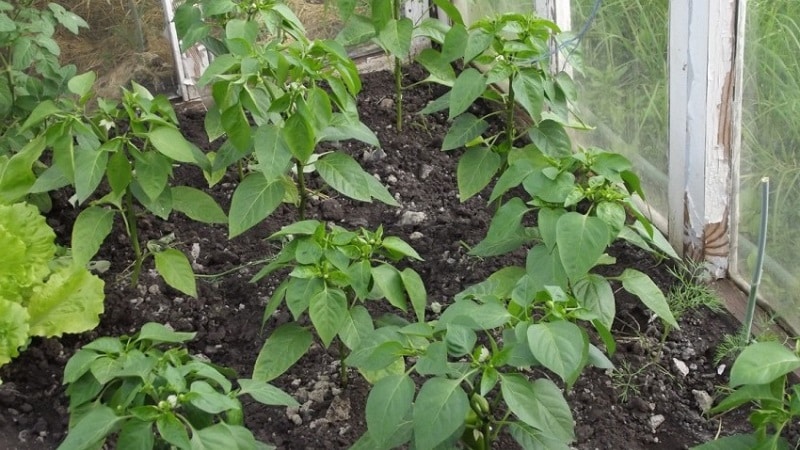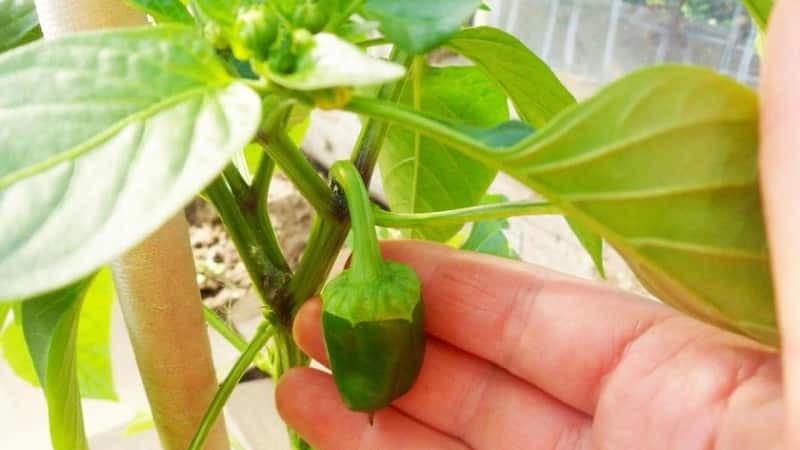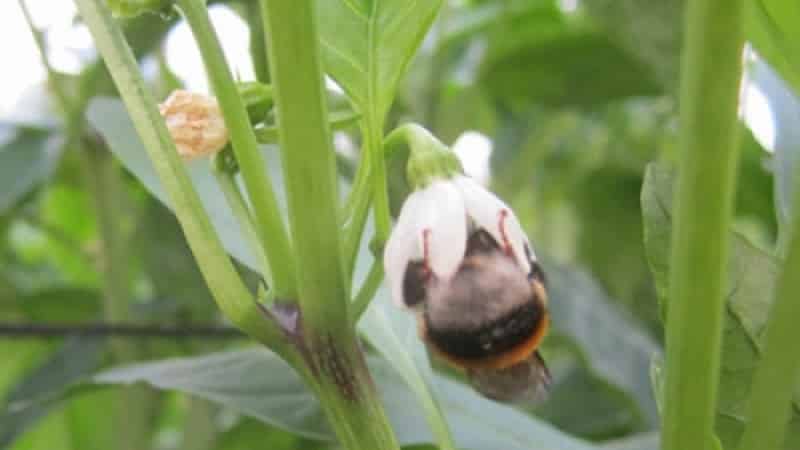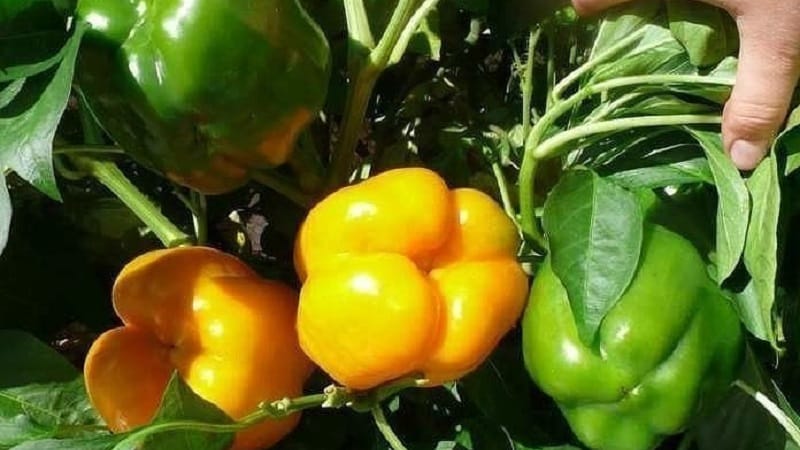Why do the ovaries of peppers fall off in a greenhouse and what to do to save your harvest?
At first glance, growing peppers is not difficult. But sometimes a vegetable can be capricious - for example, dropping flowers and ovaries. This happens even in greenhouse conditions. And if there are no ovaries, there is no harvest.
Why the ovaries of peppers fall off in a greenhouse, what are the reasons for this and how to avoid crop loss - we will tell you in the article.
The first signs of a problem
If a plant suffers from unfavorable environmental factors, this is manifested in its appearance - in the condition of roots, shoots, leaves, flowers, fruits.
But also The presence of healthy foliage and flowers in seedlings is not yet a reason to stop monitoring the plantings. After planting in a permanent place, seedlings can drop the fruits that have set.

The harbingers of this may be:
- excessively developed green or, conversely, weak and pale leaf mass in bushes;
- the presence of a transparent web on the leaves;
- weak root system of seedlings;
- other signs depending on the stress factor.
Reasons for the falling of flowers and ovaries of peppers in a greenhouse
Dropping flowers and ovaries is an acquired reaction of plants to unfavorable influence of the external environment.
The reasons for the falling of buds and ovaries in peppers are conventionally divided into four groups:
- natural causes (light, heat, humidity);
- poor nutrition (excess or lack of any nutrients);
- diseases and pests;
- agrotechnical errors.
Interesting things on the site:
Why don't peppers turn red in a greenhouse?
Lack of light, water, air humidity
 Lack of lighting, heat and moisture - a common cause of dropping flowers and ovaries in peppers.
Lack of lighting, heat and moisture - a common cause of dropping flowers and ovaries in peppers.
It is believed that the optimal length of daylight for them is 12 hours. Insufficient lighting already affects the seedling stage - seedlings in such conditions poorly absorb nutrients and grow weak and elongated.
Further with a lack of light, plants may not develop reproductive organs, and pollinating insects are reluctant to visit shaded areas. Unpollinated flowers fall off and ovaries do not form.
Important! Excessive lighting creates overheating of plants in the greenhouse, which also adversely affects their growth and development.
Optimal air humidity for crops is 60-80%. If there is a lack of moisture, it is more difficult for plants to absorb nutrients, they dry out and the ovaries fall off.
Soil moisture should also be sufficient, especially during the period of formation and ripening of fruits, since the root system of peppers is not so extensive and is located only in the upper layers of the soil.
Important! Peppers react negatively to both lack and excess moisture. In the first case, growth stops due to the accumulation of salts in the soil layer, in the second - from a lack of oxygen in it. To avoid waterlogging of the air and soil, the greenhouse is regularly ventilated.
Temperature changes
 Sudden temperature fluctuations reduce the adaptive abilities of plants and disrupt the processes of vegetative growth, including flowering and fruit formation.
Sudden temperature fluctuations reduce the adaptive abilities of plants and disrupt the processes of vegetative growth, including flowering and fruit formation.
Favorable temperature for pepper seedlings is +20-22°C.Mature plants are already more stable - for successful growth, a decrease in air temperature to +15°C is acceptable, but a further decrease increases the risk of fruit loss.
An excessive increase in temperature (more than +35°C) can lead to the falling of flowers and ovaries, and even the death of the plant.
Important! It is believed that heating the air above +30°C is harmful to pepper pollen and the formation of ovaries.
Poor soil composition
With a nutritional deficiency, the plant weakens, its growth slows down, and immunity decreases. and metabolism is disrupted. This manifests itself in the fall of the reproductive organs of the plant organism - this is how the natural self-preservation mechanism works.
By shedding formed flowers and ovaries, pepper gets rid of unnecessary stress in a stressful situation.
Reference. Of the macroelements for plants, the most important are nitrogen - for the formation of stems and leaf mass, phosphorus - for the development of strong roots and the formation of ovaries, potassium - promotes the ripening of fruits and increases the endurance of plants during temperature fluctuations.
Excess fertilizer
A similar error - overfeeding with fertilizers - gardeners do this much more often than underfeeding.
Excess nitrogen is especially undesirable, since it stimulates the active growth of stems and leaves - pepper actively grows powerful greenery to the detriment of flowers and fruits.
With an excessive amount of phosphorus and a lack of potassium, many ovaries are formed, which are likely to fall off. In a similar way, the plant protects itself from a bountiful harvest, which will become a burden.

Planting density
You should not plant peppers close to each other in the hope of getting a larger harvest.
Reference. In laboratory conditions, the dependence of pepper fruiting on planting density was determined: first there is an increase, then a decrease in yield per unit area.
Densified planting increases plant competition for nutrients and light. In such conditions, individual specimens do not receive the necessary nutrition. The stress factor leads to the fall of the ovaries.
Important! Optimal planting density of peppers per 1 sq. m greenhouses - 3-6 pieces, depending on size. The correct planting distance creates conditions for good air circulation and better protects plants from disease.
Pests and diseases
Damage by pests and diseases - a rare cause of shedding ovaries in peppers. This usually happens in particularly advanced cases.
Pests weaken the plant, all of whose strength goes into fighting infection and resisting insect pests. A weak plant loses its ability to reproduce and bear fruit, and gets rid of “ballast”.
The most common pests of peppers are spider mites and greenhouse whiteflies. Among the diseases, bacterial and fungal infections are common: late blight, blight, verticillium.
Read also:
The best sweet pepper varieties for greenhouses in the Moscow region
The best hybrids and varieties of peppers for polycarbonate greenhouses
What to do to save the harvest
To get a good harvest of peppers it is necessary to provide their needs for nutrition, lighting, temperature and humidity, be able to correct the excess or deficiency of these factors in a greenhouse climate.

Organizing proper care and correcting agrotechnical errors
There are proven techniques that can be used to correct undesirable natural or agrotechnical factors in the place where peppers are grown.
Providing lighting and heat:
- The planting method (row or checkerboard) ensures the optimal density and light requirement of peppers. Most often this is a planting pattern of 30x30 cm or 40x60 cm, depending on the variety;
- when hot weather sets in, different options for shading and ventilation are used, taking into account the intensity of solar radiation, night and day temperatures;
- During prolonged cloudy and rainy weather, additional lighting devices - phytolamps - are installed in greenhouses.
Ensuring optimal humidity:
- the frequency of watering peppers on hot days is once a week, but abundantly, after which the soil must be loosened;
- during prolonged dry weather, to ensure suitable humidity in the greenhouse, water spraying devices are installed or paths between the beds are watered daily;
- mulching the soil also protects it from drying out and overheating;
- in the morning (to avoid sunburn), the plants are sprayed or watered from a watering can over the leaves.

Adding Nutrients:
- the need to apply fertilizers is assessed based on the condition of the bushes. The optimal feeding regime is once every two weeks, alternating organic and mineral compositions;
- during the period of budding, pepper requires mainly nitrogen fertilizers, during the period of formation and ripening of fruits - phosphorus and potassium;
- if, with abundant healthy foliage, the pepper begins to shed its ovaries, stop feeding for two weeks;
- For effective absorption of nutrients, plants are provided with optimal temperature and light conditions.
Pest Control
Pest and disease control is carried out not only to prevent the falling of flowers and ovaries, but in general to preserve healthy plants.
For this There are various chemical and biological preparations: “Kleschevit” – from spider mites, “Aktara”, “Aktellik” – from whiteflies, and others.
Important! The use of strong drugs to save plants is justified only in case of significant damage to the plantings.
Most often, gardeners use more environmentally friendly methods: spraying with infusions of garlic, yarrow, chamomile, laundry soap.

Stimulation of pollination
Pepper is a self-pollinating crop, but sometimes it needs help. In order for full-fledged ovaries to form, it is recommended to stimulate pollination by periodically gently shaking the bushes in the greenhouse. You can transfer pollen from one plant to another using a cotton swab or brush.
The most suitable temperature for stimulating pollination is +23-25°C.
Important! Remember that pollen remains viable at an air temperature of no more than +30°C.
Preventive measures
Prevention of possible problems begins with cleaning the greenhouse, disinfection and proper soil preparation.
With annual use, greenhouse soil becomes depleted and pathogenic organisms appear in it. In cold climates, the soil in the greenhouse freezes in winter, thereby getting rid of pathogens naturally.
In warm climates, chemicals are used to treat the soil. It is better to use less toxic chemical or biological preparations: a solution of potassium permanganate, a solution of soda, salt and iodine (1:1:1).
In the spring, before planting, the soil is warmed up in a closed greenhouse for two weeks, after which it is filled with humus and complex mineral fertilizers. It is better to apply manure in the fall.

Advice from experienced gardeners
Summer residents and gardeners with experience share such recommendations:
- marigolds, nasturtium, and onions planted between rows protect peppers from pests;
- pepper does not tolerate transplantation well, so it is better to sow seeds for seedlings immediately in separate containers;
- in conditions of excess light, shading is provided by planting peppers surrounded by larger plants - for example, tomatoes;
- It is better to fertilize with ash not during planting, but during the period of ovary formation;
- different methods of shaping bushes affect the number or size of pepper fruits;
- for better fruiting, unnecessary shoots and leaves below the first branch are removed;
- About a month and a half before the end of the season, the growing points (tips of skeletal branches) are pinched so that the plant stops growing and the formed fruits have time to ripen.
Conclusion
The massive fall of formed ovaries of peppers is a real threat to the future harvest. To ensure that the work on growing the crop does not go in vain, you should provide the plant with optimal growing conditions in the greenhouse and subsequently monitor all changes in the condition of the seedlings.
A timely and comprehensive response to problems will help achieve the desired result.